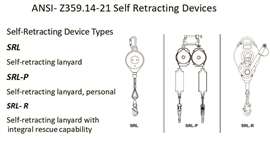Fall protection updates
June 20, 2023
A new ANSI standard will do away with “leading-edge,” or LE, designations on new self-retracting fall-arrest equipment and make the choice of types of gear more straightforward beginning August 1, 2023.
Stay calm. The American National Standards Institute issues voluntary standards for the manufacture of equipment, so changes resulting from ANSI Z359.14-2021 aren’t new regulations demanding user compliance. Key to their changes, however, is an intent to make it easier for users of fall-arrest systems to choose the right equipment for the job.
“ANSI is a compliance board that sets the standards for manufacturing the equipment,” says Becky Danielson, height safety specialist and product manager in North America for Tractel Ltd. The standard does not require a change of equipment in the field. “But the people that sit on all the subcommittees have really, really spent a lot of time and energy looking at how to get the information out there better.”
The ANSI effort reflects how equipment is actually being used in complex, changing situations like fall arrest, particularly in construction.
Understand ‘leading edge’
There had been several types of fall-arrest equipment:
- self-retracting lanyard (SRL)
- self-retracting lanyard with retrieval capability (SRL-R)
- self-retracting lanyard with leading-edge capability (SRL-LE)
These SRLs fell into two classes, A and B, based on their arrest distance and average arrest force. Ambiguity crept into some equipment choices under this system, particularly related to leading-edge applications.
 A worker demonstrates a self-retracting lanyard, fall-arrest equipment that helps keep crews safe on jobsites. (Photos by Larry Stewart)
A worker demonstrates a self-retracting lanyard, fall-arrest equipment that helps keep crews safe on jobsites. (Photos by Larry Stewart)
When somebody falls over a leading edge, the edge becomes their defacto anchor point – if the fall-arrest device isn’t on their back, the performance of the device will likely be surprising. The braking built into SRLs is based on inertia and acceleration, like a car’s retracting seatbelt, and the friction of the lanyard across the edge affects that. There’s reasonable doubt about whether the lanyard will survive the cutting strain.
“The point where the lanyard goes over the edge becomes your new anchor point, which means that there’s no energy absorption on you to absorb the amount of force that just is now going to hit that new anchor point.” Danielson says there have been cases where cable lanyards broke because of the lack of energy absorption.
Common practice had called for the LE designation on SRLs any time the user ties off at foot level. But there were very many other applications that led to lanyards snapping tight over an edge.
“The way ANSI looks at things, especially things that have a lot of variables to them, is, ‘What’s the worst thing that somebody’s going to do with this, and how can we work towards preventing that?’” says Danielson.
Customers tend to prefer nylon-web lanyards instead of the heavier cable used for LE devices and self-retracting devices tied off at the anchor point. The idea of a “smooth edge” – one that wouldn’t cut a lanyard or interrupt the performance of the fall-arrest device – snuck into the industry vocabulary with intent to allow broader use of lighter equipment.
“When we (on the ANSI Z359.14 subcommittees) started looking at the data and what people were using the equipment for,” Danielson says they learned, “The reality is that any time you’re anchoring lower than your back D-ring, you’re creating a leading edge – if you fall, you’re falling off of something.”
The new standard
The previous Class A and Class B were replaced by Class 1 and Class 2:
- Class 1 is for self-retracting devices which shall be used only on overhead anchorages and shall be subjected to a maximum free fall of 2 feet or less, in practical application.
- Class 2 is for self-retracting devices which are intended for applications where overhead anchorages may not be available or feasible and which may, in practical application, be subject to a free fall of no more than 6 feet over an edge.
“Class 1 is if your SRL is anchored directly over your head,” or above your D-ring, Danielson says. “Class 2 is everything else. An edge is an edge, period. Even if it starts out as the smoothest possible edge, how do you know that it won’t get dinged or banged?”
Types of fall-arrest equipment have changed slightly, but significantly:
- self-retracting lanyard (SRL)
- self-retracting lanyard with retrieval capability (SRL-R)
- self-retracting lanyard, personal (SRL-P)
 The competent-person inspection interval is determined by how much use and under what kind of conditions the equipment is used.
The competent-person inspection interval is determined by how much use and under what kind of conditions the equipment is used.
As before, the SRL-R is often hung from tripods and davit systems for access to confined spaces. These devices have a hand crank or other function that allows a second person to reel in the lanyard and hoist the wearer to safety.
The SRL-P is the “everything else” device that the worker carries on their back. They are designed for leading-edge applications.
“The device on your back is doing two things: it arrests your fall and absorbs the energy so that when the lanyard hits an edge – that new anchor point – it doesn’t get destroyed; and controls the force on your body.
“In construction, the scaffolding industry and suspended access, there are so many variables. The standard was rewritten to make fall-arrest equipment very easy to understand. You have Class 1 and you have Class 2,” and the choice is determined by the available anchor points.
“ANSI is trying to drive a message about making sure we get that energy absorber on the person’s back,” she says. “If you don’t have it there, that unit is going see an enormous amount of force (in the event of a fall over an edge), and a cable may not even hold up to that.”
Labeling targets confusion
 New Class-designation icons that specify the equipment’s application will be 1-inch square on SRLs and SRL-Rs. For SRL-Ps, the icon can be half-inch square.
New Class-designation icons that specify the equipment’s application will be 1-inch square on SRLs and SRL-Rs. For SRL-Ps, the icon can be half-inch square.
Construction is full of leading-edge applications. So users must still know how minimum setback, clearance and swing determine which device is best for a job.
A standardized labeling scheme prescribes a square white tag with black lettering, or vice versa, that identifies the tool’s class designation and offers guidance on how it should be anchored. The ANSI Z359.14-2021 revision also calls for marking all Class 2 devices with minimum setback distance, the clearance required for falls over an edge and a warning that “exposure to a sharp or serrated structural edge could damage the device and that the anchorage should be elevated to the extent possible to limit the risk of damage or failure.”
The revised standard more clearly defines clearance and swing so that manufacturers’ guidance in the manual and on the device is easier for the user to understand which equipment is right for the job.
Inspection remains a challenge
“I spend a lot of time in the field (working on fall prevention with equipment users),” says Danielson, “And one of the things that I’ve noticed is that inspection is still one of the biggest issues that we have in the field.”
It’s the law that all fall-protection equipment shall be inspected. The user should inspect the equipment before each use according to the manufacturer’s instructions. The revised ANSI standard points out that the inspection by a competent person other than the user should happen no less frequently than annually. The actual interval is determined by how much use and the conditions of use to which the equipment is subjected (see the table).
As it says in the name, ANSI Z359.14-2021 was finalized in 2021. February 1, 2023, was the original date by which manufacturers had to comply. That deadline was moved to August 1, 2023.
 Pictograms once again make it easy to identify types of harnesses.
Pictograms once again make it easy to identify types of harnesses.
While ANSI’s deadline is for equipment makers, buyers and users should be aware of the changes, and look for the new class system when naturally replacing fall-arrest equipment.
“When it comes to fall protection, I would say probably 95% of the OSHA investigators that I’ve talked to say they’re going to fall back on the ANSI standard when it comes to fall protection because it does a fairly decent job of making it more straightforward to choose the right tool for the job.”
Anchoring a lanyard above the wearer’s feet and below their D-ring had become a gray area before the ANSI Z359.14 revision, but Danielson says OSHA inspectors are very unlikely to cite users who comply with the previous standard. The classification change does bring light to a safer way to protect some workers at height.
Types of SRDs
The updated ANSI standard establishes requirements for three SRD types: SRL, SRL-P, and SRL-R. This classification of SRDs helps manufacturers determine the specific testing they must perform on each SRD design they offer.
Here is how the standard defines each type:
 All leading-edge applications are now covered by the SRL-P, with the fall-arrest device attached to the user’s harness.
All leading-edge applications are now covered by the SRL-P, with the fall-arrest device attached to the user’s harness.
Self-Retracting Lanyards (SRL)
The standard defines a Self-Retracting Lanyard (SRL) as “a self-retracting device in the form of a mechanical fall arrester, featuring a locking mechanism and energy management system to arrest the fall of and limit the forces imparted to the user.”
Self-Retracting Lanyard, Personal (SRL-P)
The standard defines a Self-Retracting Lanyard, Personal (SRL-P) as “a self-retracting device designed such that it is compact enough and approved by the manufacturer to be worn by the user on a full-body harness to be used as a fall arrest connector, or alternatively mounted to an anchorage. These devices may, in some cases, be available in a dual configuration for the purpose of 100% tie-off.”
Self-Retracting Lanyard with Integral Rescue Capability (SRL-R)
The standard defines a Self-Retracting Lanyard with Integral Rescue Capability (SRL-R) as “an SRL that includes an integral means for assisted rescue via raising or lowering the rescue subject. Some SRL-Rs may alternatively feature a mechanism which facilitates the controlled descent of the fallen user.”
Classes of SRDs
The recent update to Z359.14 in 2021 removed Classes A and B used in previous versions and now categorizes SRDs as either Class 1 or Class 2. These two new classifications indicate each device’s free fall capacity and if it can withstand a fall over an edge.
Class 1 SRDs
The new standard defines Class 1 SRDs as “self-retracting devices which shall be used only on overhead anchorages and shall be subjected to a maximum free fall of 2 feet (610mm) or less, in practical application.”
Class 1 devices are designed for anchorage at or above the user’s dorsal D-ring location.
Class 2 SRDs
The new standard defines Class 2 SRDs as “self-retracting devices which are intended for applications wherein overhead anchorages may not be available or feasible and which may, in practical application, be subjected to a free fall of no more than 6 feet (1.8m) over an edge.”
Class 2 devices are designed for anchorage above, at, or up to 5 feet below the dorsal D-ring of the user and rated for use during leading-edge work.
STAY CONNECTED



Receive the information you need when you need it through our world-leading magazines, newsletters and daily briefings.
CONNECT WITH THE TEAM








